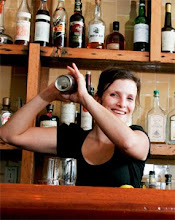
I came across orchard syrup as a cocktail ingredient for the first time while browsing the CocktailDB application on my co-worker's iphone (it was a slow night). It was in a cocktail called a St. Croix Crusta and is listed in Harry Johnson's Bartenders' Manual, in the crusta as well as several other cocktails. Additional research revealed it also listed in Here's How by Ross Bolton.
Usually when I find an ingredient I'm not familiar with I can find a recipe for it in How to Mix Drinks: A Bon Vivant's Companion, The Royal English and Foreign Confectioner or online on a site such as Chest of Books. But I can't find anything about orchard syrup. It's making me a little crazy.
On DrinkBoy there is a thread speculating on the possibilities of what this ingredient is. One plausible theory is that as orchards in America in the early part of the century tended to be apple orchards, orchard syrup was probably derived from apples.
I like this theory. My only question is that there are plenty of recipes from that era for apple syrup, so how would orchard syrup be any different? Erik from Underhill Lounge sent me this recipe. It's for a Dutch apple syrup made by greatly reducing apple syrup with some spices. And here I hope is the difference: while apple syrups tend to be sugar and water syrups cooked with apple pieces, this is only apple juice and sugar, resulting in (I imagine) a far more concentrated flavor.
It turned out delicious, really lovely and apple-y but not oxidized or caramelized, which are always risks when reducing fruit juices. And the spices are subtle enough that they add to the cocktail without overtaking it. I've been making St. Croix Crustas for any bar geeks who happen to come in. And I call it orchard syrup. But feel free to correct me (bring research)!
One note about recipes containing dashes as ingredient measurements: while a couple dashes of concentrated aromatic ingredients like bitters or absinthe is sufficient to add flavor to a cocktail, I simply cannot taste dashes of more delicate ingredients like citrus juice or syrups. I use a barspoon, or 1/2 tsp.
St. Croix Crusta
1 dash bitters (Ango works fine; it originally called for Boker's)
1 barspoon lemon juice
1 barspoon maraschino liqueur
1/4 oz orchard syrup
1 1/2 oz white St. Croix rum (I used Barbancourt white, as it's what I had available)
Using a vegetable peeler, peel a lemon in one long spiral. Run a cut lemon around a pony-style glass fairly far down the edge and dip in sugar. Place the entire lemon peel in the glass, maintaining its shape as best as possible. Shake all ingredients (or stir; I'm not arguing over this one) over ice and strain into the glass.
 My friend Nadia, enjoying the crusta.
My friend Nadia, enjoying the crusta.







